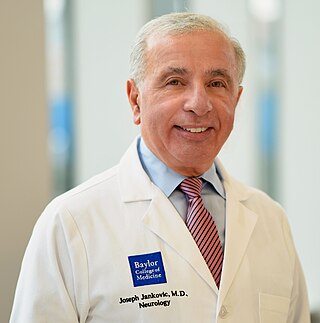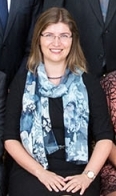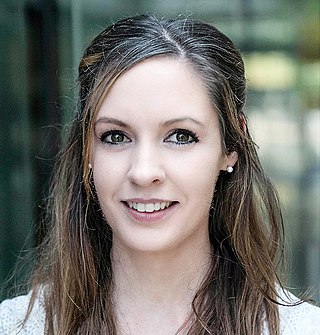Related Research Articles

Deep brain stimulation (DBS) is a surgical procedure that implants a neurostimulator and electrodes which sends electrical impulses to specified targets in the brain responsible for movement control. The treatment is designed for a range of movement disorders such as Parkinson's disease,essential tremor,and dystonia,as well as for certain neuropsychiatric conditions like obsessive-compulsive disorder (OCD) and epilepsy. The exact mechanisms of DBS are complex and not entirely clear,but it is known to modify brain activity in a structured way.

Ann Martin Graybiel is an Institute Professor and a faculty member in the Department of Brain and Cognitive Sciences at the Massachusetts Institute of Technology. She is also an investigator at the McGovern Institute for Brain Research. She is an expert on the basal ganglia and the neurophysiology of habit formation,implicit learning,and her work is relevant to Parkinson's disease,Huntington's disease,obsessive–compulsive disorder,substance abuse and other disorders that affect the basal ganglia.

Basal ganglia disease is a group of physical problems that occur when the group of nuclei in the brain known as the basal ganglia fail to properly suppress unwanted movements or to properly prime upper motor neuron circuits to initiate motor function. Research indicates that increased output of the basal ganglia inhibits thalamocortical projection neurons. Proper activation or deactivation of these neurons is an integral component for proper movement. If something causes too much basal ganglia output,then the ventral anterior (VA) and ventral lateral (VL) thalamocortical projection neurons become too inhibited,and one cannot initiate voluntary movement. These disorders are known as hypokinetic disorders. However,a disorder leading to abnormally low output of the basal ganglia leads to reduced inhibition,and thus excitation,of the thalamocortical projection neurons which synapse onto the cortex. This situation leads to an inability to suppress unwanted movements. These disorders are known as hyperkinetic disorders.

Anne Buckingham Young is an American physician and neuroscientist who has made major contributions to the study of neurodegenerative diseases,with a focus on movement disorders like Huntington's disease and Parkinson's disease. Young completed her undergraduate studies at Vassar College and earned a dual MD/PhD from Johns Hopkins Medical School. She has held faculty positions at University of Michigan and Harvard University. She became the first female chief of service at Massachusetts General Hospital when she was appointed Chief of Neurology in 1991. She retired from this role and from clinical service in 2012. She is a member of many academic societies and has won numerous awards. Young is also the only person to have been president of both the international Society for Neuroscience and the American Neurological Association.

Joseph Jankovic is an American neurologist and professor at Baylor College of Medicine in Houston,Texas. He is the Distinguished Chair in Movement Disorders and founder and director of the Parkinson's Disease Center and Movement Disorders Clinic.

Guoping Feng is a Chinese-American neuroscientist. He is the Poitras Professor of Neuroscience at the McGovern Institute for Brain Research in the Department of Brain and Cognitive Sciences at MIT and member of the Stanley Center for Psychiatric Research at Broad Institute. He is most notable for studying the synaptic mechanisms underlying psychiatric disease. In addition to developing many genetic-based imaging tools for the study of molecular mechanisms in the brain,he has generated and characterized rodent models of obsessive-compulsive disorder,autism spectrum disorders,and schizophrenia. Feng has also shown that some autism-like behaviors can be corrected in adult mice by manipulating the expression of the SHANK3 gene.

Giovanna Rachele Mallucci is van Geest Professor of Clinical Neurosciences at the University of Cambridge in England and associate director of the UK Dementia Research Institute at the University of Cambridge. She is a specialist in neurodegenerative diseases.
D. James "Jim" Surmeier,an American neuroscientist and physiologist of note,is the Nathan Smith Davis Professor and Chair in the Department of Neuroscience at Northwestern University Feinberg School of Medicine. His research is focused on the cellular physiology and circuit properties of the basal ganglia in health and disease,primarily Parkinson's and Huntington's disease as well as pain.
Ted M. Dawson is an American neurologist and neuroscientist. He is the Leonard and Madlyn Abramson Professor in Neurodegenerative Diseases and Director of the Institute for Cell Engineering at Johns Hopkins University School of Medicine. He has joint appointments in the Department of Neurology,Neuroscience and Department of Pharmacology and Molecular Sciences.
Valina L. Dawson is an American neuroscientist who is the director of the Programs in Neuroregeneration and Stem Cells at the Institute for Cell Engineering at the Johns Hopkins University School of Medicine. She has joint appointments in the Department of Neurology,Neuroscience and Physiology. She is a member of the Graduate Program in Cellular and Molecular Medicine and Biochemistry,Cellular and Molecular Biology.

Viviana Grădinaru is a Romanian-American neuroscientist who is a Professor of Neuroscience and Biological Engineering at the California Institute of Technology. She develops neurotechnologies including optogenetics CLARITY tissue clearing,and gene delivery vectors. She has been awarded the Presidential Early Career Award for Scientists and Engineers and the National Institutes of Health Director's Pioneer Award. In 2019 she was a finalist for the Blavatnik Awards for Young Scientists. In 2020 she was awarded a Vilcek Prize for Creative Promise in Biomedical Science by the Vilcek Foundation.

Meaghan Creed is a Canadian neuroscientist and associate professor of anesthesiology at Washington University in St. Louis. Creed has conducted research on understanding and optimizing deep brain stimulation in the basal ganglia for the treatment of neurological and psychiatric disorders. Her work has been recognized at the national and international level by Pfizer,the American Association for the Advancement of Science (AAAS),the Whitehall Foundation,Brain and Behavior Research Foundation and the Rita Allen Foundation.
Camilla Bellone is an Italian neuroscientist and assistant professor in the Department of Basic Neuroscience at the University of Geneva,in Switzerland. Bellone's laboratory explores the molecular mechanisms and neural circuits underlying social behavior and probes how defects at the molecular and circuit level give rise to psychiatric disease states such as Autism Spectrum Disorders.
Ilana B. Witten is an American neuroscientist and professor of psychology and neuroscience at Princeton University. Witten studies the mesolimbic pathway,with a focus on the striatal neural circuit mechanisms driving reward learning and decision making.
Michelle Gray is an American neuroscientist and assistant professor of neurology and neurobiology at the University of Alabama Birmingham. Gray is a researcher in the study of the biological basis of Huntington's disease (HD). In her postdoctoral work,she developed a transgenic mouse line,BACHD,that is now used worldwide in the study of HD. Gray's research now focuses on the role of glial cells in HD. In 2020 Gray was named one of the 100 Inspiring Black Scientists in America by Cell Press. She is also a member of the Hereditary Disease Foundation’s scientific board.
Susanne A. Schneider is a German neurologist at the Ludwig Maximilians-Universität in Munich,Germany who is known for her work in movement disorders.
Mary Kay Lobo is an American psychiatric neuroscientist who is a Professor of Neurobiology at the University of Maryland School of Medicine. Her research considers the molecular mechanisms that underpin drug addiction and depression. She was named a finalist in the 2011 Blavatnik Awards for Young Scientists.

Serena M. Dudek,Ph.D.,is an American neuroscientist known for her work on long-term depression and synaptic plasticity in the CA2 region of the hippocampus.
Christine Klein is a German physician who is a professor of neurology and neurogenetics at the University of Lübeck. Her research considers the molecular genetics of movement disorders. She is a Fellow of the European Academy of Neurology,former President of the German Neurological Society and incoming President of the European Section of the International Parkinson and Movement Disorder Society.
References
- ↑ "Science Fair". Boca Raton News. May 18, 1984. Retrieved January 25, 2023– via newspapers.com.
- 1 2 "Nicole Calakos, MD, PhD". Harrington Discovery Institute. Archived from the original on July 2, 2022. Retrieved January 25, 2023.
- ↑ "Merit scholarship semi-finalist sets high goal of becoming microsurgeon". Boca Raton News. September 19, 1983. Retrieved January 25, 2023– via newspapers.com.
- 1 2 "Nicole Calakos, MD, PhD". American Society for Clinical Investigation . Retrieved January 25, 2023.
- ↑ "Nicole Calakos, MD, PhD". Michael J. Fox Foundation. Retrieved January 25, 2023.
- ↑ Welch, Jeffrey M.; Lu, Jing; Rodriguiz, Ramona M.; Trotta, Nicholas C.; Peca, Joao; Ding, Jin-Dong; Feliciano, Catia; Chen, Meng; Adams, J. Paige; Luo, Jianhong; Dudek, Serena M.; Weinberg, Richard J.; Calakos, Nicole; Wetsel, William C.; Feng, Guoping (August 2007). "Cortico-striatal synaptic defects and OCD-like behaviours in Sapap3-mutant mice". Nature . 448 (7156): 894–900. doi:10.1038/nature06104. PMC 2442572 . PMID 17713528.
- ↑ Yeager, Ashely; Leif Bates, Kark (February 18, 2013). "THE 'SIXTH SENSE' OF MICE, BIRD SONG & FIGHTING CRIME". Duke University. Retrieved January 25, 2023.
- 1 2 "Scientists Develop New Drug Screening Tool for Dystonia". Duke University. December 9, 2016. Retrieved January 25, 2023.
- ↑ "DUKE INSTITUTE FOR BRAIN SCIENCES ANNOUNCES AWARDS FOR COLLABORATIVE RESEARCH PROJECTS". Duke University. June 2, 2008. Retrieved January 25, 2023.
- ↑ "Duke Neurologist Wins a McKnight Memory and Cognitive Disorder Award". Women In Academia Report. December 26, 2013. Retrieved January 25, 2023.
- ↑ "STUDY POINTS TO FAST-ACTING DRUG FOR OCD". Duke University. July 15, 2016. Retrieved January 25, 2023.
- ↑ "Thirty-six Faculty Members Named Duke Health Scholars and Fellows". Duke University School of Medicine. November 11, 2016. Retrieved January 25, 2023.
- ↑ Alexander, William (December 5, 2018). "Duke Trio Shares $1 Million Award to Understand Genetic Roots of Parkinson's Disease". Duke University. Retrieved January 25, 2023.
- ↑ "Meet the 2020 Distinguished Professors". Duke University. May 26, 2020. Retrieved January 25, 2023.
- ↑ "Nicole Calakos, Stephen G. Lisberger, and Sallie R. Permar Named Fellows of the American Association for the Advancement of Science". Duke University. November 24, 2020. Retrieved January 25, 2023.
- ↑ "Nicole Calakos Elected to U.S. National Academy of Medicine". Duke University. October 17, 2022. Retrieved January 25, 2023.
- ↑ "Richard James Steffan". Cochran Funeral Home. Retrieved January 25, 2023.